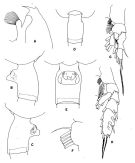|
|
 |
Fiche d'espèce de Copépode |
|
|
Calanoida ( Ordre ) |
|
|
|
Clausocalanoidea ( Superfamille ) |
|
|
|
Euchaetidae ( Famille ) |
|
|
|
Euchaeta ( Genre ) |
|
|
| |
Euchaeta magniloba Park, 1978 (F) | |
| | | | | | | Syn.: | Paraeuchaeta magniloba : Bradford & al., 1983 (p.23); Pareuchaeta magniloba : Heinrich, 1990 (p.17, 20: Rem.) | | | | Ref.: | | | Park, 1978 (p.215, Descr.F, figs.F); Park, 1995 (p.25, Rem.F, figs.F) |  issued from : T. Park in Antarctic Res. Ser. Washington, 1978, 27. [p.216, Fig.73]. Female: A, forehead (lateral); B, C,D,E, distal end of metasome and genital segment (left side, right side, dorsal and ventral, respectively); F, outer lobe of Mx1; G, P1; H, P2. P1-2: legs (anterior). Nota : Proportional lengths of prosome and urosome 65 : 35. Frontal eminence of forehead pronounced, bearing suprafrontal sensilla ; rostrum large, pointing nearly downward and curving slighlly backward. Posterolateral corner of metasome not produced posteriorly, with broadly rounded margin either dorsal or lateral view. Dorsally, genital segment with its widest part far anterior to middle of segment, slightly asymmetrical with its right side more convex than its left. Genital prominence arising from anterior half of segment and pointing directly downward. Genital flanges nearly symmetrical, posterior half of each enlarged into large lobe pointing downward posterior to genital orifice. Ventrally, genital field about symmetrical. Appendicular caudal setae straight, much thicker and longer than terminal setae. Outer coxal lobe of Mx1 with 5 long setae in addition to a short seta distally. Mx2: 1 of 6 apical setae bearing long, widely separated spines in addition to usual short, spinules found along its entire length. Mxp with long endopodal setae terminating in spinules. In P1, first 2 exopodal segments fused, with short line reoresenting fused segmentation; resulting compound segment with single external spine reaching distal end of following segment. In P2, external spine of 2nd exopodal segment reaching middle of first external spine of 3rd. 1st and 3rd external spines of 3rd exopodal segment about equally small; 2nd about as large as external spine of 2nd segment and reaching about 3/4 way to base of following, 3rd external spine. Incision posterior to 2nd external spine of 3rd segment deep.
|
 issued from : T. Park in Bull. Scripps Inst. Oceanogr. Univ. California, San Diego, 1995, 29. [p.124, Fig.14]. Female: forehead (left side); b, urosome (left); c, d, e, genital somite (left, ventral, right, respectively); f, A2; g, outer lobe of Mx1.
|
 Euchaeta magniloba Euchaeta magniloba Female: 1 - See Key to acuta species Group. 2 - Dorsally, genital somite nearly symmetrical. 3 - Laterally, rostrum slender (Fig.14-a). Genital flange not spiniform (Fig.14-b). 4 - Genital flanges right and left similar in size (Fig.14-c, e).
| | | | | NZ: | 3 | | |
|
Carte de distribution de Euchaeta magniloba par zones géographiques
|
| | | | Loc: | | | E Juan Fernandez Is., Pacif. (E & central tropical), off W Colombia, Pacif. (SE tropical).
Type locality: 33°S, 84°W. | | | | N: | 3 | | | | Lg.: | | | (3) F: 3,64-3,24; {F: 3,24-3,64} | | | | Rem.: | After Park (1978, p.217) the definitive systemartic position of the species may not be determined until the discovery of its male. The presence of one maxillary apical seta that is furnished with long, widely separated spines and of large, nongenicularted appendicular caudal setae well defines this species as allying to E. acuta, E. media or E. spinosa.
For Park (1995, p.22) this species belongs to ‘’acuta ’’ Group.
Similar in habitus to E. acuta, but rostrum in lateral view longer and curved backward; left genital flange less pointed, right flange more elongated, genital somite in both dorsal and ventral view more or less symmetrical. All cephalosomal appendages similar to those of E. acuta except: last exopodal segment of A2 without an inner marginal seta; outer lobe of Mx1 with 6 setae, the most distal of which is much shorter than the others.
Park found this species in the south eastern Pacific respectively at 3°N, 81°W, in the eastern tropical Pacific at 10°N, 150°W and in the central Pacific at 15°N, 160°W. | | | Dernière mise à jour : 05/01/2015 | |
|
|
 Toute utilisation de ce site pour une publication sera mentionnée avec la référence suivante : Toute utilisation de ce site pour une publication sera mentionnée avec la référence suivante :
Razouls C., Desreumaux N., Kouwenberg J. et de Bovée F., 2005-2025. - Biodiversité des Copépodes planctoniques marins (morphologie, répartition géographique et données biologiques). Sorbonne Université, CNRS. Disponible sur http://copepodes.obs-banyuls.fr [Accédé le 19 octobre 2025] © copyright 2005-2025 Sorbonne Université, CNRS
|
|
 |
 |





